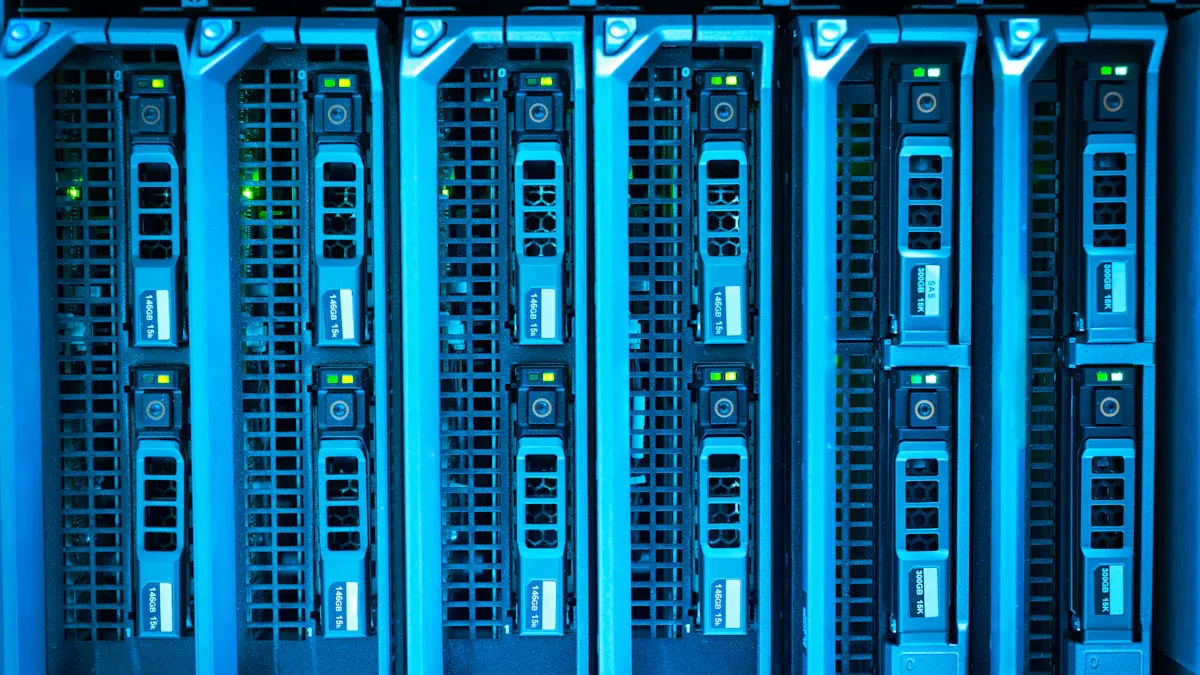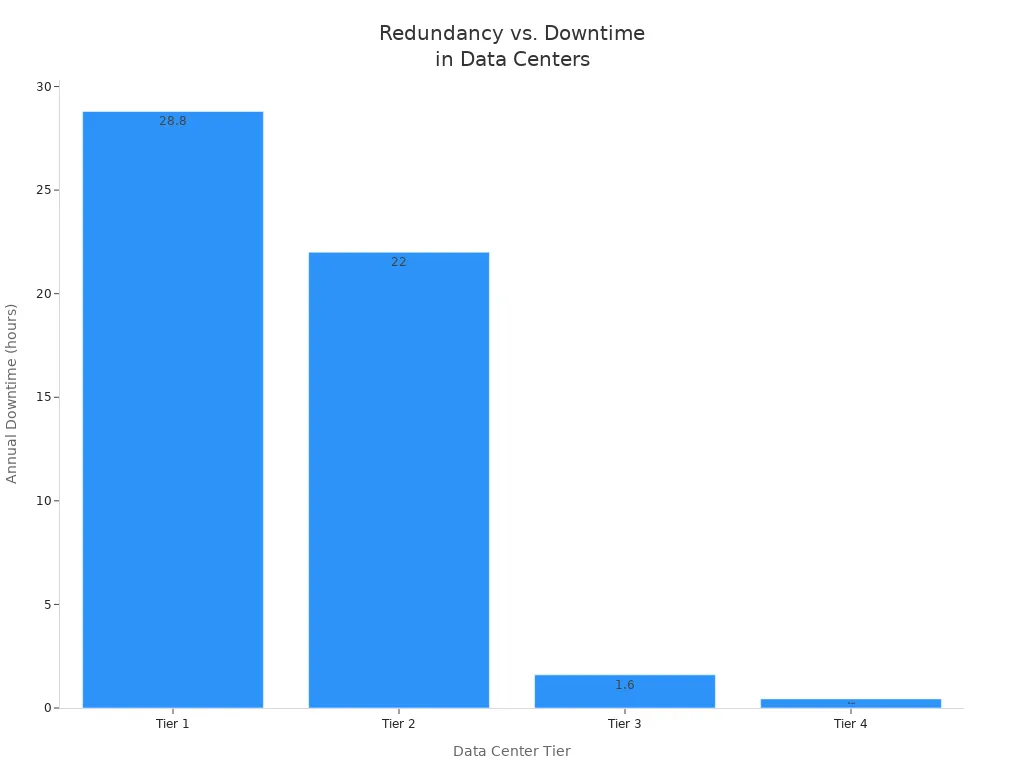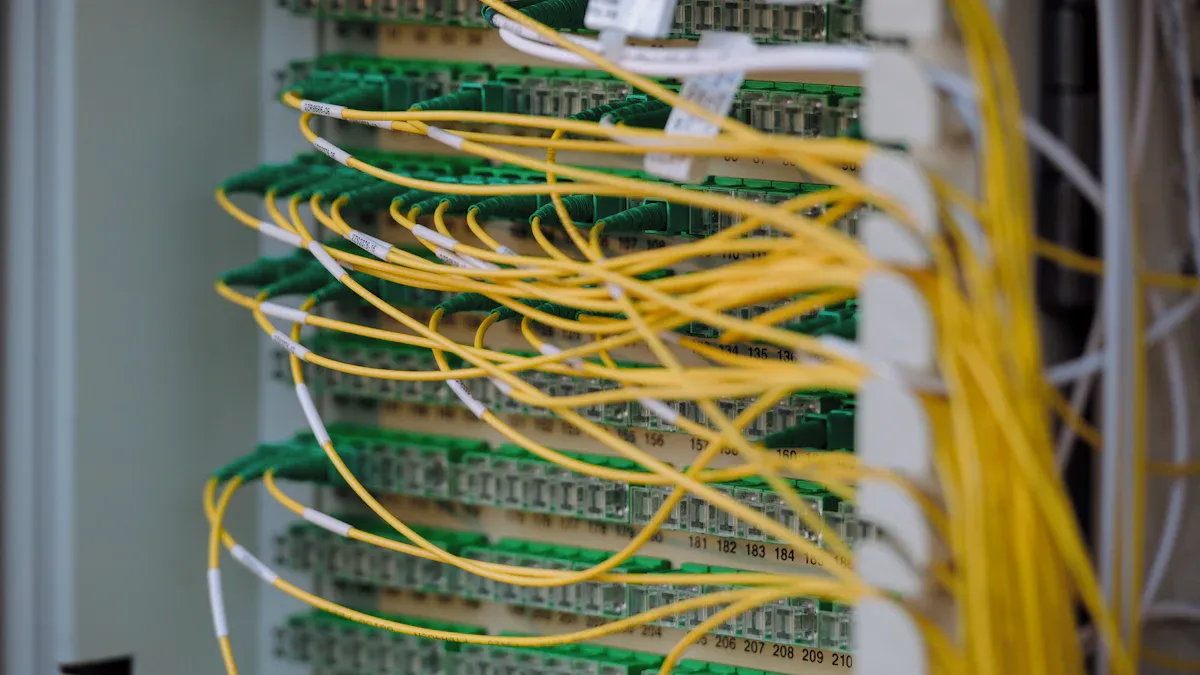
A Power Distribution Unit, or PDU, manages electrical power for IT equipment in data centers. A Basic PDU delivers reliable energy to racks, while an Intelligent PDU tracks power use and supports remote control. These devices enhance uptime, support high-density environments, and enable efficient, scalable power management.
Key Takeaways
- PDUs deliver reliable and efficient power to data center equipment, helping prevent overloads and reduce downtime through smart monitoring and load balancing.
- Intelligent PDUs enable remote control and real-time power tracking, allowing administrators to manage devices easily and respond quickly to issues from anywhere.
- Modular and flexible PDU designs support data center growth by allowing easy upgrades and better space use, ensuring power systems keep pace with changing needs.
Top 10 Ways a PDU Works in Modern Data Centers

Centralized Power Distribution with PDUs
Modern data centers rely on centralized power distribution to deliver reliable energy to every rack. PDUs are typically installed per rack, distributing power to multiple devices efficiently. This approach supports several PDU types, including:
- Basic PDUs: simple power strips that deliver unfiltered AC power.
- Metered PDUs: provide real-time power consumption data for load optimization.
- Monitored PDUs: offer digital meters and remote monitoring.
- Switched PDUs: allow remote control of outlets and detailed monitoring.
- Switched Metered-by-Outlet PDUs: combine outlet-level control and monitoring.
Common form factors include rack-mounted, wall-mounted, and intelligent PDUs. Centralized distribution enables redundancy by connecting multiple PDUs to separate power sources, helping manage loads and avoid overloads. This structure enhances energy efficiency by allowing precise, real-time monitoring at the outlet and rack levels. Smart PDUs help administrators identify inefficiencies, optimize usage, and support sustainability initiatives, often leading to energy savings of up to 20-30%.
PDU Load Balancing for Equipment Protection
PDUs play a vital role in load balancing, which protects sensitive equipment from power fluctuations and overloads. They use integrated current monitoring to measure real-time consumption, enabling precise load analysis. By distributing power evenly across circuits, PDUs prevent overloads and ensure stable operation. Built-in circuit breakers trip when current exceeds safe limits, providing overload protection. Surge protection devices, such as Metal Oxide Varistors and resettable fuses, absorb high-voltage surges. Intelligent PDUs support remote monitoring and proactive load management, while locking outlets and hot-swap features maintain stable power delivery and continuous operation.
Remote Monitoring and Management via PDU
Intelligent PDUs offer advanced remote monitoring and management features. Administrators can access real-time power usage data and environmental conditions from anywhere. Outlet-level monitoring allows remote switching on, off, or rebooting of devices. Detailed metrics, such as voltage and current at each outlet, help optimize energy usage. Alert notifications inform users of potential issues, enabling proactive intervention. Integration with Data Center Infrastructure Management (DCIM) software provides centralized oversight. Remote management transforms incident response from reactive to proactive, reducing downtime and improving operational efficiency.
PDU Redundancy for Uptime and Reliability
Redundancy is essential for maximizing uptime in mission-critical data centers. PDUs support various redundancy configurations, such as N+1, N+2, 2N, and 2(N+1). The table below summarizes these configurations:
| Redundancy Level | Description | Key Components Involved |
|---|---|---|
| N+1 | One extra component for every required component, allowing failover without downtime. | Generators, UPS, PDUs, ATS |
| N+2 | Two extra backup components, enhancing reliability further. | Generators, UPS, PDUs, ATS |
| 2N | Complete mirrored system with two of every component for full backup. | Generators, UPS, PDUs, ATS |
| 2(N+1) | Highest redundancy combining full duplication with an additional backup, used in hyperscale or Tier IV facilities. | Generators, UPS, PDUs, ATS |
Automatic Transfer Switches (ATS) enable seamless switching between power sources. The impact of redundancy is clear:

As redundancy increases, annual downtime drops significantly, with Tier 4 data centers achieving less than 26.3 minutes of downtime per year.
Scalability with Modular PDU Solutions
Modular PDUs enable data centers to scale power distribution as needs evolve. These units allow flexible addition or removal of modules, supporting future-proof infrastructure. Plug-and-play modules and compatibility with renewable energy sources simplify upgrades and maintenance. Modular PDUs can be reconfigured remotely, reducing the need for physical changes and minimizing downtime. This flexibility supports seamless expansion, cost efficiency, and operational reliability as data centers grow.
Individual Outlet Control on PDUs
Switched PDUs provide individual outlet control, allowing administrators to remotely power on, off, or reboot equipment. This feature enhances operational flexibility and reduces the need for on-site interventions. By limiting power usage at the outlet level, PDUs help prevent accidental overloads and improve efficiency. Real-time monitoring at each outlet enables informed decisions, optimizing resource allocation and supporting sustainability efforts. Scheduling power cycling of unused equipment further reduces energy consumption and operational costs.
Environmental Monitoring Integration in PDUs
Modern PDUs often integrate environmental sensors, such as temperature, humidity, and airflow sensors. These sensors provide real-time monitoring of rack and data center conditions, helping maintain optimal performance. Alarm systems alert operators to adverse conditions, preventing equipment failures. Environmental monitoring ensures equipment operates within safe thresholds, reducing maintenance costs and extending hardware lifespan. Integration with DCIM software allows proactive management and operational reliability.
Surge Protection and Power Conditioning by PDUs
Data center PDUs incorporate advanced surge protection technologies. Side-mounted surge protectors, rated between 200,000 and 300,000 AMPs, shield sensitive equipment from high-voltage surges. These protectors can be replaced quickly without shutting down the facility. Intelligent PDUs provide real-time monitoring and alert systems, enabling proactive detection of power anomalies. Case studies show a 30% reduction in downtime incidents and up to 20% energy savings in data centers using intelligent PDUs. Features like proper grounding, isolation, and energy-saving modes further enhance operational reliability.
Flexible PDU Form Factors and Mounting
PDUs come in various form factors to suit different data center needs. Rack-mounted PDUs, typically 1U or 2U, fit standard racks and monitor power loads. Vertical (0U) mounting allows installation without occupying rack space, optimizing space utilization. The table below compares horizontal and vertical PDUs:
| Aspect | Horizontal PDUs | Vertical PDUs |
|---|---|---|
| Space Utilization | Occupy 1U or 2U rack space, preserving vertical space for other equipment | Mount along rack sides without occupying rack space, allowing more equipment in the same cabinet |
| Cable Management | Provide structured layout, reduce cable clutter | Allow shorter cable runs, reduce tangling, improve airflow |
| Installation | Require rack space and cooling considerations | Tool-less mounting options; easier installation and maintenance |
| Power Capacity | Typically fewer outlets, suitable for moderate power demands | More outlets, handle greater heat loads, suitable for high power demands |
| Airflow & Cooling | Improved airflow by reducing cable clutter | Better airflow due to side mounting and less cable clutter |
Flexible form factors improve organization, cooling, and maintenance efficiency.
PDU Integration with Data Center Management Systems
Integrating PDUs with DCIM platforms delivers measurable benefits for power usage effectiveness (PUE). Real-time, granular monitoring at the outlet level enables precise power allocation and identification of underutilized equipment. Facilities using this integration report up to a 20% reduction in energy consumption and improved PUE, sometimes as low as 1.2. Centralized management consolidates power metrics, environmental data, and equipment performance, supporting proactive load balancing and predictive maintenance. These capabilities optimize energy usage, reduce operational costs, and enhance sustainability, while also reducing downtime risks by up to 20%.
Choosing the Right PDU for Your Data Center

Key PDU Features to Consider
Selecting the right power distribution unit involves careful evaluation of several features. Data center managers should:
- Calculate total device consumption and include a 20-30% buffer for future expansion.
- Determine the number of outlets needed for all connected equipment.
- Assess redundancy requirements to maintain high availability.
- Decide on monitoring and control features, such as remote management and outlet-level monitoring.
- Choose the appropriate form factor, considering rack layout and available space.
- Evaluate environmental conditions, including temperature and humidity.
- Ensure compliance with industry safety standards.
- Select between basic and managed PDUs based on monitoring and control needs.
- Include surge protection and circuit breakers for equipment safety.
- Review manufacturer reputation, innovation, and support services.
Tip: Prioritize modular or expandable designs to accommodate future growth and changing power needs.
The table below highlights important features for high-density deployments:
| Feature Category | Details and Benefits |
|---|---|
| Power Capacity & Input | Supports 10kW to 90kW+; input current from 16A to 125A; voltages from 208V to 480V |
| Circuit Protection | Up to 24 hydraulic-magnetic circuit breakers, rated at 20A, 10kAIC |
| Power Quality Monitoring | ±0.5% energy metering accuracy; monitors voltage, harmonic distortion, dips/swells |
| Environmental & Security | Sensors for airflow, temperature, humidity; smart locks; asset management tags |
| Flexibility & Reliability | Universal input options; plug-and-play accessories; secure communication |
Matching PDU Types to Data Center Requirements
Different data center environments require specific PDU types. The table below summarizes the main options:
| PDU Type | Description | Best For |
|---|---|---|
| Basic PDU | Simple power strip, no monitoring or remote access | Budget setups, stable environments |
| Metered PDU | Local real-time power usage data, no network access | Basic efficiency insights, no remote monitoring |
| Monitored PDU | Remote monitoring, alerts, historical data | Critical environments needing proactive control |
| Switched PDU | Remote control of individual outlets, power cycling, shutdown | Multi-site IT, remote or unmanned locations |
| Intelligent PDU | Advanced monitoring, control, DCIM integration, outlet-level management | Enterprise and colocation facilities |
A basic PDU suits simple, stable setups. Metered and monitored models provide more insight and control, while switched and intelligent PDUs offer advanced features for complex or high-density data centers. Managers should match the PDU type to their operational needs, growth plans, and budget.
Modern data centers rely on advanced power distribution for reliability, safety, and efficiency.
- Smart monitoring, remote management, and environmental sensing support uptime and cost savings.
- Safety protocols and regular maintenance reduce risks, as shown below:
| Safety Aspect | Best Practice |
|---|---|
| Arc Flash Risk | Use protective equipment and follow standards |
| Maintenance | Schedule inspections and train personnel |
Selecting the right PDU involves matching features to workload, planning for growth, and ensuring compliance.
FAQ
What is the difference between a basic PDU and an intelligent PDU?
A basic PDU distributes power without monitoring. An intelligent PDU provides remote management, outlet-level control, and real-time data for advanced power optimization.
How does a PDU help prevent equipment downtime?
A PDU monitors power loads, balances circuits, and provides surge protection. These features reduce overload risks and help maintain continuous equipment operation.
Can a PDU be upgraded as data center needs grow?
Many modular PDUs support upgrades. Technicians can add or replace modules to increase capacity or add features, ensuring the system adapts to future requirements.
Tip: Choose modular PDUs for easy scalability and long-term flexibility.
Post time: Jul-23-2025

